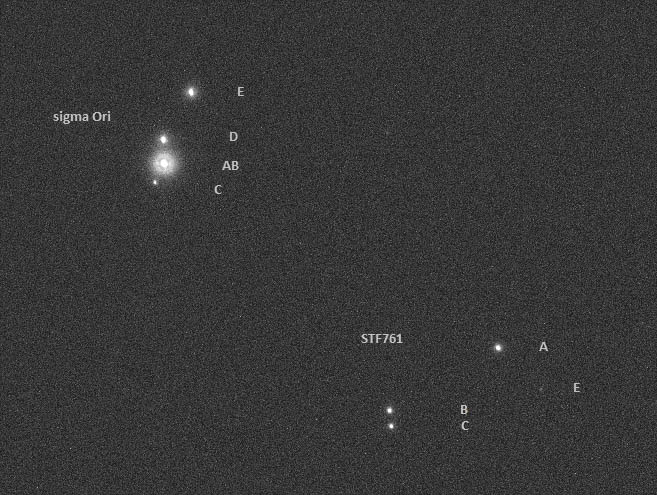by Dave Blane — 2013 December 27
For January we get two for the price of one! The multiple star, Sigma Orionis (STF762) is a five-star system in the constellation of Orion about 1 degree south of Alnitak, the easternmost star in Orion’s belt and similar distance west of the Horsehead nebula.
So when you have finished marvelling at the Orion nebula (M2), move your scope 3 degrees north and have a look at one of the most spectacular multiple star systems, sigma Orionis or STF762, and, as a bonus, in the same field of view is another interesting multiple system STF761,
The primary component is the binary Sigma Orionis AB but with the separation of the two stars being a mere 0.25 arcseconds, they will not be resolved in small telescopes but are within the range of the 26 inch refractor in Johannesburg. Recently, spectroscopic studies have suggested that the A component may have a massive component making AB a very massive triple system.
Below is the abstract of a paper published in the Astrophysical Journal titled “A THIRD MASSIVE STAR COMPONENT IN THE SIGMA ORIONIS AB SYSTEM” by S Simon-Diaz, JA Caballero and J Lorenzo. The paper makes interesting reading for anyone interested in these important massive systems in the Orion star forming region.
“We report on the detection of a third massive star component in the σ Orionis AB system, traditionally considered as a binary system. The system has been monitored by the IACOB Spectroscopic Survey of Northern Massive Stars program, obtaining 23 high-resolution FIES@NOT spectra with a time span of ~2.5 years. The analysis of the radial velocity curves of the two spectroscopic components observed in the spectra has allowed us to obtain the orbital parameters of the system, resulting in a high eccentric orbit (e ~ 0.7O8) with an orbital period of 143.5 ± 0.5 days. This result implies the actual presence of three stars in the σ Orionis AB system when combined with previous results obtained from the study of the astrometric orbit (with an estimated period of ~157 years)”.
The next brightest stars in the system are sigma Orionis D and E, which lie about 4,600 and 15,000 AU respectively from the AB pair. Both are seven solar mass B-type dwarf stars with magnitudes of 6.62 and 6.66. Sigma Orionis E is a prototype of the strange “helium-rich” stars, which have significantly large amounts of helium.
The last star in the system is Sigma Orionis C, an A-type dwarf star. C is the closest to the AB pair, about 3,900 AU away.
How does your view compare with the image captured by Jerome Jooste using the 6 inch Franklin Adams refractor in the Johannesburg Centre’s Papadopoulos dome?

Below is a table giving the position angles and separations of the components of the sigma Ori system.
Table 1. Washington Double Star Catalog values for sigma Orionis (STF772)
| WDS | Disc | Comp | Obs 1 (yr) | Obs 2 (yr) | PA 1 (deg) | PA 2 (deg) | Sep 1 (arcsec) | Sep 2 (arcsec) | mag 1 | mag 2 |
| 05387-0236 | STF 762 | AB,C | 1831 | 2012 | 235 | 240 | 11.6 | 10.7 | 3.76 | 8.79 |
| 05387-0236 | STF 762 | AB,D | 1779 | 2013 | 85 | 84 | 13.4 | 12.9 | 3.76 | 6.56 |
| 05387-0236 | STF 762 | AB,E | 1777 | 2013 | 55 | 62 | 37 | 41.3 | 3.76 | 6.34 |
| 05387-0236 | STF 762 | DC | 1831 | 2013 | 251 | 252 | 23.6 | 23.8 | 6.56 | 8.79 |
| 05387-0236 | STF 762 | EC | 1831 | 2011 | 240 | 241 | 52.3 | 52.6 | 6.34 | 8.79 |
| 05387-0236 | STF 762 | ED | 1779 | 2013 | 231 | 232 | 31.4 | 29.8 | 6.34 | 6.56 |
- Browse the Newsletter Archives.
